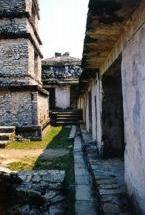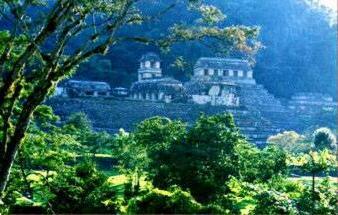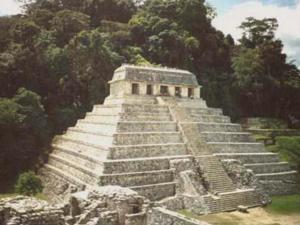Palenque
Spiritual centre of the Maya civilization, flourished c. 300 - 900.
Palenque, in today's Chiapa state of Mexico, was the westernmost city of the Mayan civilization and therefore the location of the setting sun, representing the death of day.  Death and the underworld had a very profound significance to the Mayans, and the location of this city was probably selected by design. An observer standing on top of the watchtower of the palace during the winter solstice saw the sun plunge down straight into the earth, leading the way to the underworld. Pacal, the most powerful of all the rulers of Palenque had his tomb constructed at that location. His pyramid tomb thus appears as a direct gateway to the underworld.
Death and the underworld had a very profound significance to the Mayans, and the location of this city was probably selected by design. An observer standing on top of the watchtower of the palace during the winter solstice saw the sun plunge down straight into the earth, leading the way to the underworld. Pacal, the most powerful of all the rulers of Palenque had his tomb constructed at that location. His pyramid tomb thus appears as a direct gateway to the underworld.
More than 500 buildings are known, but more than 80% of the city are today covered by rainforest. The original name of the city is lost, and it is today known after the neighbouring village of Santo Domingo de Palenque.
The outside walls of Palenque's buildings were not finished in the usual Mayan limestone face but were plastered to show a smooth finish. Carvings decorated the interiors. Stucco and terra-cotta were also used. Some buildings, particularly the "Temple of the Inscriptions", show extensive writing, which has yet to be deciphered.

The watchtower and the palace.

The palace.
home
 Death and the underworld had a very profound significance to the Mayans, and the location of this city was probably selected by design. An observer standing on top of the watchtower of the palace during the winter solstice saw the sun plunge down straight into the earth, leading the way to the underworld. Pacal, the most powerful of all the rulers of Palenque had his tomb constructed at that location. His pyramid tomb thus appears as a direct gateway to the underworld.
Death and the underworld had a very profound significance to the Mayans, and the location of this city was probably selected by design. An observer standing on top of the watchtower of the palace during the winter solstice saw the sun plunge down straight into the earth, leading the way to the underworld. Pacal, the most powerful of all the rulers of Palenque had his tomb constructed at that location. His pyramid tomb thus appears as a direct gateway to the underworld.
